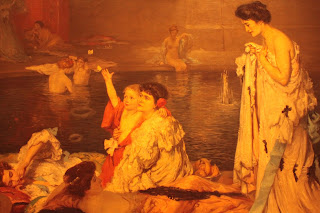In 2011, I spent 4 days in Brisbane. I was there with my then girlfriend, and now wife. We really enjoyed our time there. The main highlight was spending time with animals at the Australia Zoo and the Lone Pine Koala Sanctuary. In several Australian zoos, visitors are allowed to enter the enclosures of non dangerous animals, touch them, get photographed with them and even feed them, and that was really a unique, thrilling experience. Brisbane was also the city where I saw the final of the 2011 Cricket World Cup, where India beat Sri Lanka. I went to one of the lively pubs on Queen Street and saw the match till the wee hours of the morning. The pub was full of Indians (we are everywhere, aren't we?), and the wild celebrations that followed after India's victory almost made me forget that I wasn't in India!!
Brisbane is Australia’s 3rd largest city after Sydney
and Melbourne. It has a population touching 2 million, and it is the capital of
the state of Queensland. The city has a charm of its own, and is also a
stopping point for visitors interested in going to the Great Barrier Reef or the
Gold Coast. The history of Brisbane dates back to 1823,
when the Governor of New South Wales decided to move select convicts to a new
location. Brisbane became the capital of Queensland in 1859. The presence of
natural resources led to rapid mining, which in turn led to the city’s
development.
City Hall dates back to
1930, and is famous for its soaring clock tower and
classical façade. It lies in the heart of the city and is one of Brisbane's most prominent landmarks. Outside City Hall, there's an equestrian statue of King George V of England.
 |
| City Hall |
 |
| Equestrian Statue of King George V of England, City Hall |
Customs House, with its copper
dome, is one of the city’s oldest buildings and is now used for civic
functions. It was restored in 1994.
 |
| Customs House |
ANZAC
Square commemorates soldiers from Australia and New Zealand, who
died for their country in various battles. The Greek cenotaph is the main sight
in this square, and it has an Eternal Flame.
 |
| ANZAC Square |
 |
| ANZAC Memorial |
 |
| Eternal Flame, ANZAC Memorial |
 |
| Vietnam War Memorial, ANZAC Square |
Overlooking ANZAC Square, the General
Post Office is an attractive neo-classical building completed in 1879.
 |
| General Post Office |
St
John’s Anglican Cathedral dates back to 1901. The cathedral’s architecture is of French
Gothic style.
 |
| St John's Anglican Cathedral |
 |
| High Altar, St John's Anglican Cathedral |
St
Stephen’s Cathedral, an English Gothic Cathedral, was completed in 1874. The
cathedral has twin spires, and right next to it is St Stephen’s Church,
Brisbane’s oldest church.
 |
| St Stephen's Cathedral |
Queensland
Art Gallery, which is a part of the larger Queensland Cultural Centre,
boasts of works of art by Australian artists, but the collection also has some
works by international masters.
 |
Boyd's Berwick Landscape,
Queensland Art Gallery |
 |
Rivers' Under The Jacaranda,
Queensland Art Gallery |
 |
Rupert Bunny's The Bathers,
Queensland Art Gallery |
 |
Tintoretto's Rising Christ,
Queensland Art Gallery |
 |
Winifred Rumney's Barron Falls,
Queensland Art Gallery |
Brisbane
Museum, also a part of the Queensland Cultural Centre, has a vast
collection that includes stuffed animals, dinosaur skeletons, automobiles,
aircraft and other objects.
 |
| Aircraft, Brisbane Museum |
 |
| Crocodile, Brisbane Museum |
The
Parliament faces the Botanical Garden, and is a large domed building.
 |
| The Parliament |
Queens
Street, Brisbane’s main shopping street, is a charming pedestrianized street full of
shops, restaurants, pubs and cafes.
 |
| Pig N Whistle, Queens Street |
Lone Pine Koala Sanctuary opened
way back in 1927. It has a large collection of koalas, and boasts of a koala
breeding programme. Other highlights include being able to mix freely with
kangaroos & emus, watching sheep dogs round up sheep before their shearing,
feeding lorikeets, and a host of Australian wild and farm animals.
 |
| Koala, Lone Pine Koala Sanctuary |
 |
| Kangaroo, Lone Pine Koala Sanctuary |
 |
| Emu, Lone Pine Koala Sanctuary |
 |
| Crocodiles, Lone Pine Koala Sanctuary |
 |
| Lorikeets, Lone Pine Koala Sanctuary |
Australia
Zoo, set up by the well known TV presenter and animal
conservationist Steve Irwin (tragically killed by a sting ray in 2006), ranks
among the world’s top zoos. It allows visitors to experience animals like
very few other places can. The zoo is 70 km outside Brisbane. Highlights
include the 5,000 seat Crocosseum (where one can see shows with crocodiles and other
animals), watching tigers play with trainers, seeing cheetahs being taken for
walks on leashes, visitors getting to feed elephants, and visitors getting to touch
animals like kangaroos and emus.
 |
| Bronze Sculpture of Steve Irwin and Family, Australia Zoo |
 |
| Kangaroo, Australia Zoo |
 |
| Koala, Australia Zoo |
 |
| Crocodile, Australia Zoo |
 |
| Trainer walking a Cheetah, Australia Zoo |
So Brisbane was something really special and we really enjoyed ourselves. For animal lovers, it's really hard to match what the city has to offer. Besides that, the museums, the churches, the vibrant city centre with its shopping and eateries, and the friendly people all make Brisbane a really pleasant place for travelers.



























































